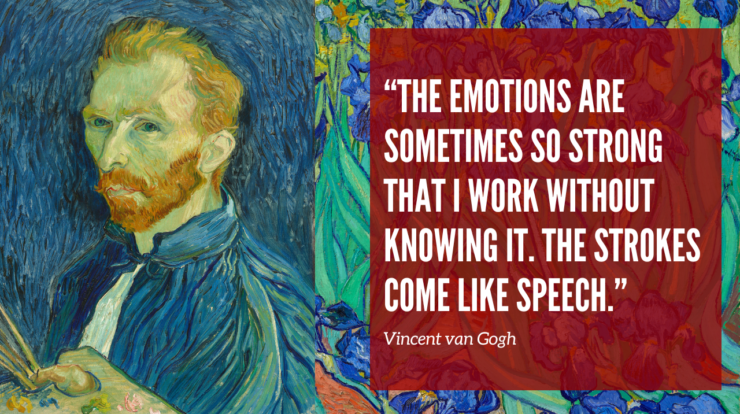
“The emotions are sometimes so strong that I work without knowing it. The strokes come like speech.” – Vincent van Gogh
This spring, I finally read Irving Stone’s biographical novel about the life of Vincent van Gogh, Lust for Life (I loved it). I had previously read Steven Naifeh and Gregory White Smith’s excellent biography, Van Gogh – The Life (twice!) and have long been fascinated by the Dutch artist’s story and his work.
The outline of the artist’s life is well-known but I came across the quote above recently wanted to share it. It’s from a letter to his brother, Theo, and it’s a great reminder of the importance of following creative impulses. I stand in awe of artists and your ability to paint, draw, sculpt, perform, write, etc. I’m also fascinated by the process and the way that artists develop and refine both their skills and their vision.
Creating is a very intimate, personal thing, but it’s amazing how you are able to express yourself in a way that has the power to resonate with all of us. To do so, you often have to ignore the “sensible” to follow your vision and passion, as van Gogh did.
Brief Biographical Outline
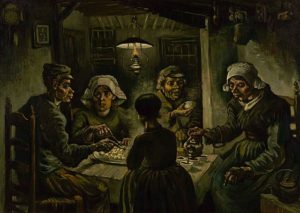
Vincent Willem van Gogh was a Dutch post-Impressionist painter who is among the most famous and influential figures in the history of Western art. In just over a decade, he created about 2,100 artworks, including around 860 oil paintings, most of them in the last two years of his life in Southern France, where he died. They include landscapes, still lives, portraits and self-portraits, and are characterized by bold colors and dramatic, impulsive and expressive brushwork that contributed to the foundations of modern art. His suicide at 37 followed years of mental illness and poverty. (Though, without offering any spoilers, I’ll mention that Naifeh and White Smith propose an alternate cause of the artist’s death)
Born into an upper-middle-class family, Van Gogh drew as a child and was serious, quiet, and thoughtful. As a young man, he worked as an art dealer, often traveling, but became depressed after he was transferred to London. He turned to religion and worked as a missionary in southern Belgium.
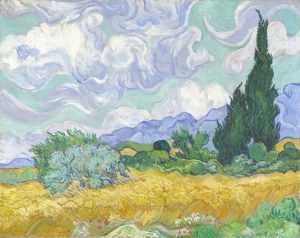
Van Gogh drifted into ill health and solitude before taking up painting in 1881, having moved back home with his parents.
His younger brother Theo supported him financially, and the two kept up a long correspondence by letter. His early works, mostly still lifes and depictions of peasant laborers, contain few signs of the vivid color that distinguished his later work.
In 1886, he moved to Paris, where he met members of the avant-garde, including Émile Bernard and Paul Gauguin, who were reacting against the Impressionist sensibility. As his work developed, he created a new approach to still lifes and local landscapes. His paintings grew brighter in color as he developed a style that became fully realized during his stay in Arles in the south of France in 1888. During this period, he broadened his subject matter to include a series of olive trees, wheat fields, and sunflowers.
Van Gogh suffered from psychotic episodes and delusions, and though he worried about his mental stability, he often neglected his physical health, did not eat properly, and drank heavily. His friendship with Gauguin ended after an explosive confrontation. In a rage, van Gogh severed part of his own left ear.
He spent time in psychiatric hospitals, including a period at Saint-Rémy. After he discharged himself and moved to the Auberge Ravoux in Auvers-sur-Oise near Paris, he came under the care of the homeopathic doctor Paul Gachet. His depression continued, and on 27 July 1890, Van Gogh shot himself in the chest with a revolver (or did he? see parenthetical above). He died from his injuries two days later.
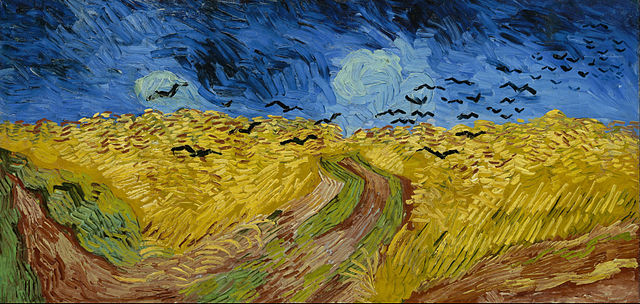
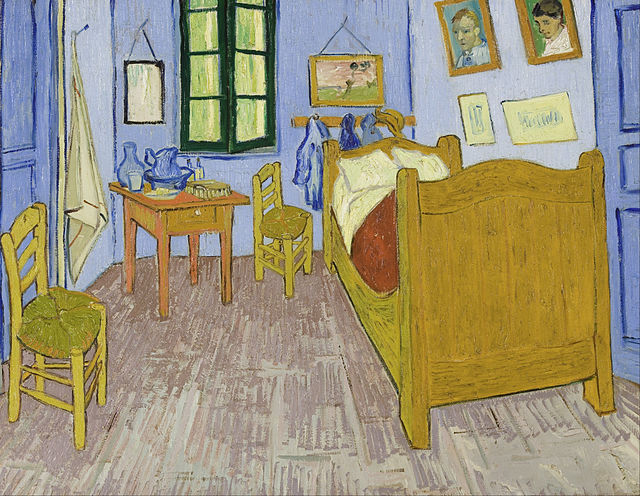
Love Van Gogh?
What are your thoughts on Van Gogh and his work? What are some of your favorite Van Gogh works? Do you ever feel like you are in a place beyond consciousness as Van Gogh did according to his letter to Theo? Leave your thoughts in the comments below.
What a coincidence! In the last week I’ve been listening to lectures about Van Gogh by John Walsh, formerly of the Met in NYC and the MFA in Boston. His lectures are found on YouTube – the Yale Art Gallery. Then another lecture or two. But just today I listened to an hour’s program on Vincent’s letters to Theo., and THEN I saw your own post. I’m going to continue learning about this artist.
I’ll have to check the lecture out – thanks for the heads up!
From my book: An Artist Empowered:
However, it appears that far from being the isolated lunatic on the fringe, van Gogh was a practical and methodical artist with a healthy sense of his times, coupled with an interest in science, astronomy, poetry, and literature.
As Becky Hendrick, in her fine book, Getting it, puts it: “He was a great painter in spite of his mental illness, not as a result of it.” Van Gogh wasn’t mad when he painted or wrote letters, especially to his brother, Theo, which were clear, pragmatic, and mindful of his mission as an artist.
One could argue, as art history professor Albert Boime does, that Vincent was less mad and more a victim; he suffered seizures that were most likely brought on by a form of epilepsy; he didn’t recall cutting off his earlobe, and this frightened him.
On July 27, 1890, van Gogh left for a nearby field (earlier that month in the fields he had painted vast stretches of wheat, crows, and turbulent skies) where he shot himself—which might be explained away by a seizure, but not why he had a pistol with him.
You can read Vincent van Gogh’s letters here:
http://www.webexhibits.org/vangogh/
It soon becomes evident that Vincent was aware of his surroundings and place in the universe. Also, although brother Theo helped support his artist brother, he had no appreciation of his unique art.
Thank you for sharing Eden!
Vincent Van Gogh suffered from chronic, cellular, systemic, carbon monoxide poisoning from unvented gas lights in the late 19th century. Side effects of CO poisoning include extreme sensitivity to sight, sound, touch, and delusions(or is it extra sight?). This is why his color palette changed from the dark, heavy colors to the light bright colors after he moved into the yellow house in Arles with gas lighting. Edgar Allen Poe also suffered with CO poisoning. As Albert Donnay, from the MCS resource center at Johns Hopkins told me, it makes one a great artist but it is extremely painful and difficult to live with. Luckily, it is easily curable with oxygen. Unfortunately, they didn’t know any of this during Van Gogh’s life.
Interesting insight Charlene – thanks!
I learned in college that he most likely suffered from the toxicity of cadmium paint pigments. Artists often use their lips to shape their brushes which I find a terribly hard habit to break. The CO poisoning does make sense. Would not be surprised that it would be both.
I am very impassioned with Van Gogh and his work. I have a massive book by Marc Edo Tralbaut , which I’ve poured over cover to cover. Plus Dear Theo, which is excellent. When the film “Loving Vincent ” came out, I read about it’s making, saw it (excellent) and bought a reproduction from one of the frames of the film. Sat and stared at his work in the Musee d’Orsay. Twice.
And keep watching that clip from Dr. Who.
The church at Auvers, The Starry night and the final painting with the crows above the field are probably my favorites.
I’ll have to check out the Tralbaut book and Dear Theo. I saw Loving Vincent and loved the idea and the execution.
I was one of the artists selected to work on Loving Vincent. While in Poland painting for the film, I listened to an audiobook version of his letters to Theo as inspiration for my work. Studying his work and brushwork up close was wonderful and it was an honor to pay tribute to him through that film.
Excellent, Dena – what an honor indeed!
“Dear Theo” and “Loving Vincent” are both wonderful. One can see Van Gogh’s influence throughout much of my artwork.
I once read a suggestion that some neighborhood gang of kids that would bully him, because he was weird, might have been the ones that actually killed him….any news of that?
Yes Robert R. I also have heard a similar claim put forth by a scholarly bio. It seems VG may have been horsing around with a gun and the “gang of kids” & may have been accidentally shot. He initially survived the gunshot wound & managed to get home but what’s usually not mentioned is that the police investigated the incident & visited him for a statement. Apparently he made no complaint or implicated anyone. He died sometime soon afterward.
If this is generally the circumstance to VG’s death (and the fact that he did not kill himself) I find pertinent to the realty of his frame of mind around the time of his death.
I have always been very moved by Van Gogh’s work. I am sometimes very emotional when I paint. And will look back at a piece with no memory of the decision process that brought the strokes about. I can only imagine the intensity with which Van Gogh felt and painted.
Here is my humble commentary and experience about this unique artist, Vincent Van Gogh. As many of you did, I also read about his story and, as an artist myself, I wanted to explore his technique.
One day, I decided to paint a study of one of my favorite Van Gogh’s ” Le semeur au coucher du soleil “, choosing the same size of his. (What a surprise for me, because it was a small painting!…)
Trying to be in his mood, looking from my left eye for the left side of the painting, and my right eye for the right part of the painting. What a challenge at the beginning, confusing to!
But as I went further, I really felt plenty of joy during painting, even more, when I repeated the whole painting with the knife (spatule) all over.
I chose my mixed lightening colors, closest to his.
What an experience really satisfying!
It encouraged myself to respect my feelings and express what I want to share and communicate from my heart.
Love the results and it guides myself to still persue the research of the best parts of the artist in me !
Thank you MASTER Van Gogh for your talent!
You should try it too!
Regards!
Oh, Van Gogh?! One of my ultimate to me. What I really like about him is that he had great vision and conviction and I wouldn’t like to say madness, because he had a uniqueness so much misunderstood.
A lot of us may have gone through that faze in some way, because of having other innovative ideas different from the norm. He showed us a lot of the way and had courage to do that in his days, but was not rewarded during lifetime. He must have been good then!
He certainly is inspirational, so much so as I learnt about year ago, that Van Gogh is a favourite of another ultimate of mine, David Hockney, another grand painter. No wonder I love his work, I thought to myself? Can you see the connection between the two?
Both expressive especially colour, lines and perspective, both bold.
More and more has been written about his health (physical and mental) and his ear and his relationship with his brother, to the point “we” have “created” Vincent Van Gogh. Jackson Pollock’s alcohol issues are another creation in terms of hype.
For those of you who haven’t seen it yet, I highly recommend “At Eternity’s Gate” starring Willem Dafoe as VanGogh. I feel it explains the ear and the death in reasonable, though controversial to some, ways. “Loving Vincent” is another excellent Van Gogh movie where every frame is hand painted.
Frequently I paint in a zone where time is of no essence. I get lost in the canvas for hours as it develops and sometimes have no explanation for what I had just painted. I usually listen to music of various genres and have found myself painting the brush or palette strokes to the beat of what I’m hearing. It can feel as if I’m not purposely in that composition but being inspired at the time by some artists. Van Gogh is one. Monet is another. Tom Thomson. And probably Corot. Also my late artist mother especially for portraiture. A very eclectic group !
Having no formal art education, I am happy when people remark when my works remind them of certain artists. I find I have to google too many of them , but that’s ok. It’s a pleasure to feel I’ve been influenced without knowing their works.
I do paint with intention most of the time but I am always feeling awe when I feel stuck , and the answer floats in.
Too many of Vincent’s works are favorites to name them.
Thank you Jason. In spite of Vincent’s life long troubles he had his art and he let it take him where it would. “To do so, you often have to ignore the “sensible” to follow your vision and passion, as van Gogh did.” I get that, ignoring what was already working and going off in a different direction was the best thing I ever did for my art. Maybe not following the sensible really is the more sensible way.
Van Gogh created, not because of his mental issues, but despite them.
If you read his many letters, Vincent was aware of what was going on in his world.
https://www.webexhibits.org//vangogh/
I recently saw the wonderful exhibition in the Metropolitan Museum of Art in NY focused on his cedar trees, and I had an unexpectedly emotional reaction to Starry Night. I thought about the crowds that filed past and the millions more that would recognize the image which he himself considered a failure. I thought about how his paintings didn’t sell and how he was rejected by his fellow painters and the public. Now people buy tickets just to get a glimpse of his work in museums all over the world. If you haven’t seen his work in person I urge you to do so. The thick brushstrokes express the urgency he had about conveying his vision. The image is amazingly powerful.
I felt compelled to paint my reaction to the experience, humbly acknowledging his genius. I called mine Celestial Navigation
Personally I believe he was shot by the gang of youths who teased him and included a relative who had access to a gun owned by his father. Vincent may have remained silent to protect the boy. If it had been suicide he picked a slow painful death by shooting a location that was not immediately fatal, and why was it he sought help after the shooting.
Regardless of how or why he died, he lived as an extraordinary artist.
Great article on Van Gogh Jason, I live near Carmel by the Sea in California and work with artists in my area with an e/brochure to help them get gallery presentation a little like what you have taught on Google Slides. I sent you a copy to share if you care to.
I, too, loved Stone’s book. In fact your article makes me want to read it again, thanks.
Have you read, “The Secret Life of Sunflowers “? It’s a historical fiction account of Van Gogh’s sister-in-law’s struggle to complete her husband’s dream of helping the world appreciate Vincent’s work. I really enjoyed it.
I read the book last year. It’s fabulous and well worth reading. so many intimate details about the artist’s life.
I have to admit that Van Gogh is my favorite artist. Even more than Claude Monet who I hold in very high regard. What I am amazed by is the breadth of his art. He experimented with everything and a variety of genres. He inspires me!
Thank you so much for this wonderful story of Van Gogh, Jason. Like everyone else who has commented here, I have read and watched everything about this extraordinary artist that I could find. He brought color and bold strokes to artists in the 19th century, and thanks to our wonderful technology, all of us can explore, learn and exemplify this amazing painter, a true artist because he overcame fear to experiment.
Hi Jason, I really enjoyed your article on Van Gogh! I live near Carmel-by-the-Sea in California and collaborate with local artists to create e-brochures that assist them with gallery presentations, similar to what you’ve discussed using Google Slides. I’ve sent you a copy of the brochure for you to check out if you’re interested.
Such an interesting article, Jason.
I had the great privilege of visiting the Van Gogh Museum in Amsterdam this summer. A fascinating and added bonus was an amazing exhibition of the Chinese-Canadian artist Matthew Wong who drew inspiration from Van Gogh among others. I would like to suggest that Wong would make another fascinating piece for your Moment in Art History.
I remembering reading Lust for Life in my early 20s during lunch breaks at work…and turning my face to the wall because I cried my eyes out the more I read. I “felt” him the times I visited the sanitorium in Saint-Rémy. There’s a replica of his room. It’s not hard to imagine walking in his shoes in those areas he dwelled or place local scenes in his paintings. I was thrilled the time I went to Arles, wandered into a square and recognized the cafe terrace. It’s one thing to see an image online or in a book. It’s completely another level to stand in front of his work and experience all the emotion that went into it. (I know you know this.) And to stumble upon scenes that inspired him is a thrill. I’ve been wanting to return to the Van Gogh Museum for a very long time. On the alternate cause of death you allude to I came across that somewhere. It’s entirely plausible…
The sheer volume of painting in those last few years is not believable except for the fact of the canvasses.
i’ve seen two shows of his works. “The Stusio of the South” in Chicago was so intense that it reverberates even today over a decade later. I wept almost constantly and ultimately had my own personal guard following me through the exhibit. (maybe it was my motorcycle jacket as well?)
When one looks closely at a Van Gogh canvas and notes that every brush stroke is put down and not retouched, your quotation I think speaks to that. He certainly changed the way we consider the artist and whar is involved.
If you haven’t seen the “Van Gogh” episode from “Dr.Who”, it’s well worth the 47 minutes.
Thoroughly enjoyed your piece on Van Gogh. I have alwsys loved his brushwork and have been fortunate enough to see several pieces of his work. To a swer your inquiry, yes, i have had a couple of experiences while working that have been “out of body”, so to speak. The most memorable involved two art works. I had started painting an abstract piece on a moderately large canvas and stopped for the day planning to finish the next day. Several studio days later i was looking for this painting to finish it and couldn’t find it anywhere. Eventually I realized I had started work on it at some point I had an intensely inspired urge to paint an entirely different piece over the original, while having no memory of it. The resulting art work gets lots of attention from clients and i love to tell the back story but i never offer it for sale. It is called Ghost Fires and was inspired by tragic canyon fires in my area.
Great article. I have created a series of oil paintings inspired by Van Gogh and themes around his life whilst mentoring a veteran artist. The work produced can be seen at @artistloadescarter My strange spiritual moment was when I was painting, referencing his last known painting roots and listening to the music he loved Wagner and then the veteran dm’d me and said it was the anniversary of Van Gogh’s death that day!
Not as big of a fan like my retirement age coworker, Victor, but very much admire his work.
Victor is an art lover and The Starry Night was his favorite but his wife disliked it so much, it would never be something he could hang on the wall.
Because we chatted about art quite a bit, I mentioned my trip to Vietnam and meeting up with a proprietor of a gallery whom could arrange to get replicas of Masters for a reasonable fee. Secretly, he asked me to have the piece reproduced.
There were ~4 paintings I wanted to have done and added The Starry Night. It was an absolutely beautiful thick oil reproduction ($75 USD in 2002) at approx. the same original size. The next day at work, he was all too excited to tell me that his wife was so impressed, that she would have it stretched & framed. Had to share.
I love how you highlighted van Gogh’s powerful connection between emotion and creation. It’s so inspiring to see how artists, like him, embrace their impulses to create something so meaningful. Your reflection on the process reminds us that art is not just skill, but a deep personal expression.